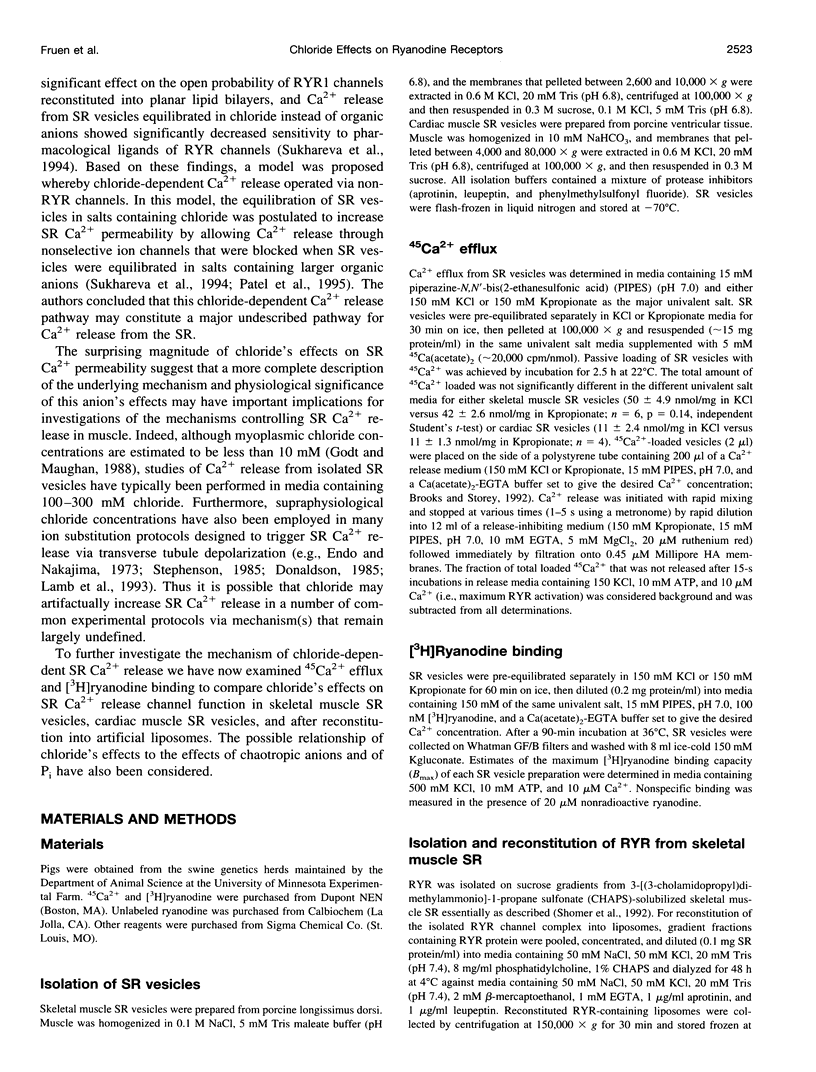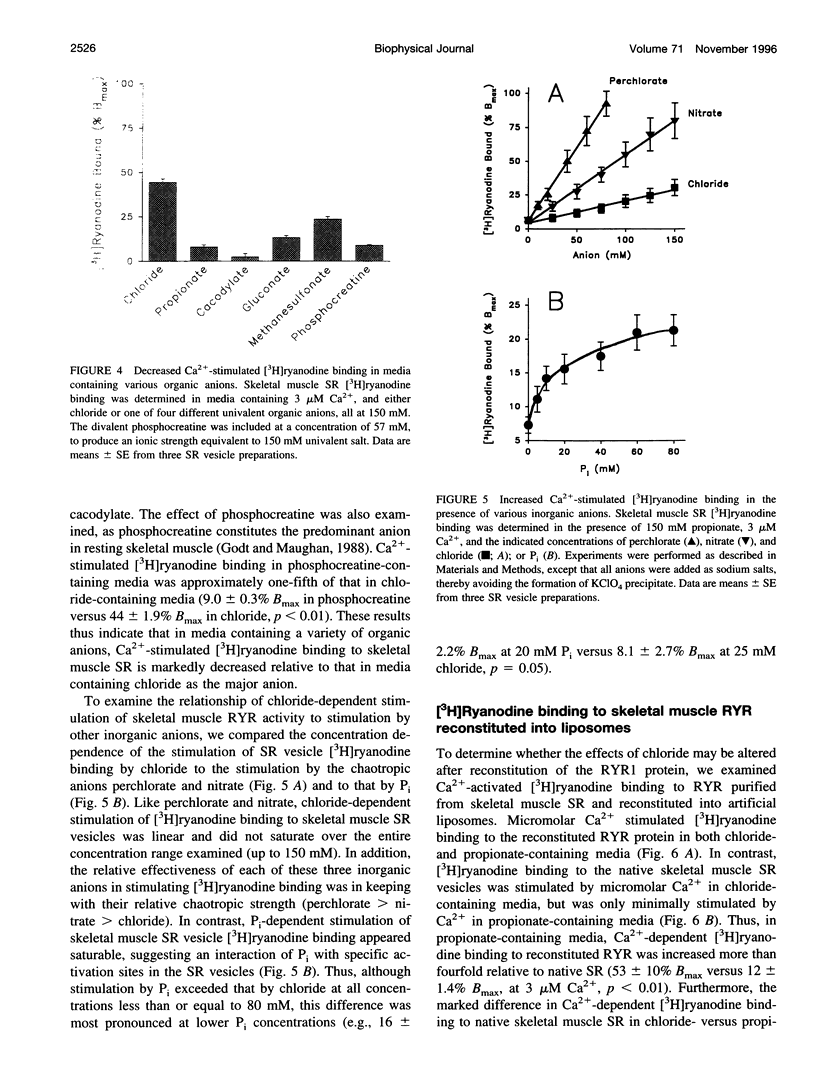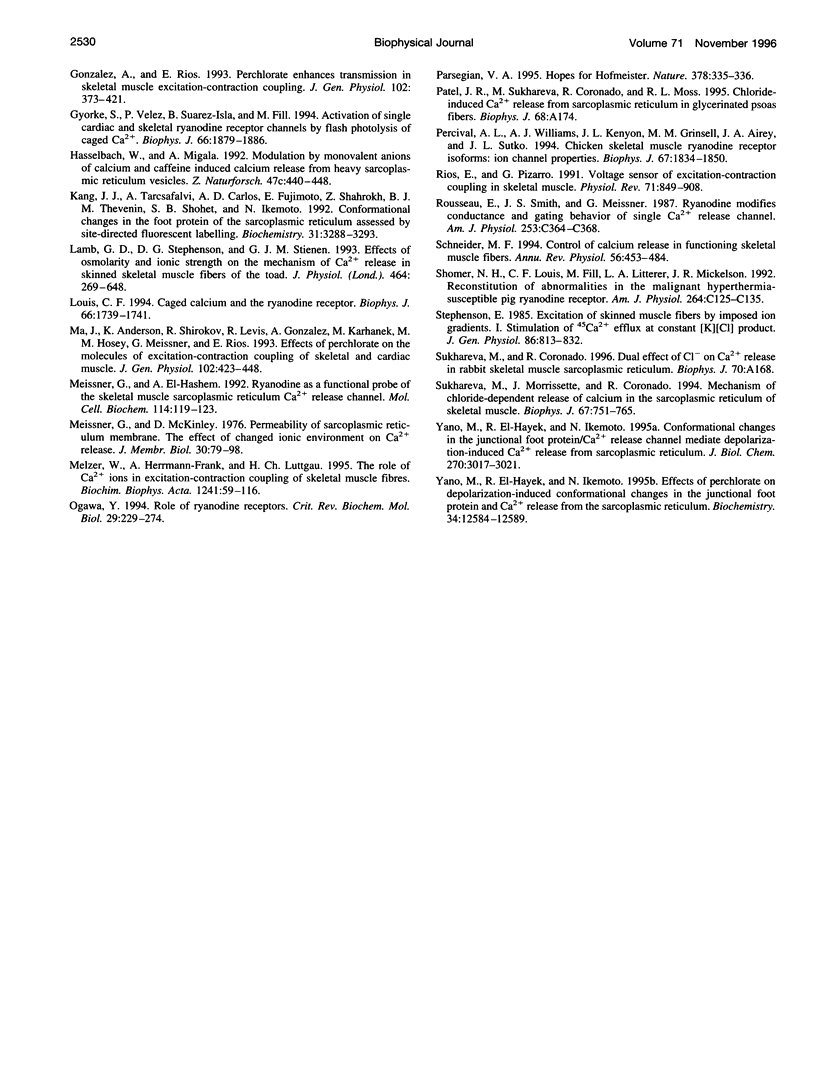Abstract
The mechanism by which chloride increases sarcoplasmic reticulum (SR) Ca2+ permeability was investigated. In the presence of 3 microM Ca2+, Ca2+ release from 45Ca(2+)-loaded SR vesicles prepared from procine skeletal muscle was increased approximately 4-fold when the media contained 150 mM chloride versus 150 mM propionate, whereas in the presence of 30 nM Ca2+, Ca2+ release was similar in the chloride- and the propionate-containing media. Ca(2+)-activated [3H]ryanodine binding to skeletal muscle SR was also increased (2- to 10-fold) in media in which propionate or other organic anions were replaced with chloride; however, chloride had little or no effect on cardiac muscle SR 45Ca2+ release or [3H]ryanodine binding. Ca(2+)-activated [3H]ryanodine binding was increased approximately 4.5-fold after reconstitution of skeletal muscle RYR protein into liposomes, and [3H]ryanodine binding to reconstituted RYR protein was similar in chloride- and propionate-containing media, suggesting that the sensitivity of the RYR protein to changes in the anionic composition of the media may be diminished upon reconstitution. Together, our results demonstrate a close correlation between chloride-dependent increases in SR Ca2+ permeability and increased Ca2+ activation of skeletal muscle RYR channels. We postulate that media containing supraphysiological concentrations of chloride or other inorganic anions may enhance skeletal muscle RYR activity by favoring a conformational state of the channel that exhibits increased activation by Ca2+ in comparison to the Ca2+ activation exhibited by this channel in native membranes in the presence of physiological chloride (< or = 10 mM). Transitions to this putative Ca(2+)-activatable state may thus provide a mechanism for controlling the activation of RYR channels in skeletal muscle.
Full text
PDF








Images in this article
Selected References
These references are in PubMed. This may not be the complete list of references from this article.
- Brooks S. P., Storey K. B. Bound and determined: a computer program for making buffers of defined ion concentrations. Anal Biochem. 1992 Feb 14;201(1):119–126. doi: 10.1016/0003-2697(92)90183-8. [DOI] [PubMed] [Google Scholar]
- Campbell K. P., Shamoo A. E. Chloride-induced release of actively loaded calcium from light and heavy sarcoplasmic reticulum vesicles. J Membr Biol. 1980;54(1):73–80. doi: 10.1007/BF01875378. [DOI] [PubMed] [Google Scholar]
- Chu A., Díaz-Muñoz M., Hawkes M. J., Brush K., Hamilton S. L. Ryanodine as a probe for the functional state of the skeletal muscle sarcoplasmic reticulum calcium release channel. Mol Pharmacol. 1990 May;37(5):735–741. [PubMed] [Google Scholar]
- Coronado R., Morrissette J., Sukhareva M., Vaughan D. M. Structure and function of ryanodine receptors. Am J Physiol. 1994 Jun;266(6 Pt 1):C1485–C1504. doi: 10.1152/ajpcell.1994.266.6.C1485. [DOI] [PubMed] [Google Scholar]
- Delcour A. H., Tsien R. W. Altered prevalence of gating modes in neurotransmitter inhibition of N-type calcium channels. Science. 1993 Feb 12;259(5097):980–984. doi: 10.1126/science.8094902. [DOI] [PubMed] [Google Scholar]
- Donaldson S. K. Peeled mammalian skeletal muscle fibers. Possible stimulation of Ca2+ release via a transverse tubule-sarcoplasmic reticulum mechanism. J Gen Physiol. 1985 Oct;86(4):501–525. doi: 10.1085/jgp.86.4.501. [DOI] [PMC free article] [PubMed] [Google Scholar]
- Fruen B. R., Mickelson J. R., Roghair T. J., Cheng H. L., Louis C. F. Anions that potentiate excitation-contraction coupling may mimic effect of phosphate on Ca2+ release channel. Am J Physiol. 1994 Jun;266(6 Pt 1):C1729–C1735. doi: 10.1152/ajpcell.1994.266.6.C1729. [DOI] [PubMed] [Google Scholar]
- Fruen B. R., Mickelson J. R., Shomer N. H., Roghair T. J., Louis C. F. Regulation of the sarcoplasmic reticulum ryanodine receptor by inorganic phosphate. J Biol Chem. 1994 Jan 7;269(1):192–198. [PubMed] [Google Scholar]
- Gallant E. M., Taus N. S., Fletcher T. F., Lentz L. R., Louis C. F., Mickelson J. R. Perchlorate potentiation of excitation-contraction coupling in mammalian skeletal muscles. Am J Physiol. 1993 Mar;264(3 Pt 1):C559–C567. doi: 10.1152/ajpcell.1993.264.3.C559. [DOI] [PubMed] [Google Scholar]
- Godt R. E., Maughan D. W. On the composition of the cytosol of relaxed skeletal muscle of the frog. Am J Physiol. 1988 May;254(5 Pt 1):C591–C604. doi: 10.1152/ajpcell.1988.254.5.C591. [DOI] [PubMed] [Google Scholar]
- González A., Ríos E. Perchlorate enhances transmission in skeletal muscle excitation-contraction coupling. J Gen Physiol. 1993 Sep;102(3):373–421. doi: 10.1085/jgp.102.3.373. [DOI] [PMC free article] [PubMed] [Google Scholar]
- Györke S., Vélez P., Suárez-Isla B., Fill M. Activation of single cardiac and skeletal ryanodine receptor channels by flash photolysis of caged Ca2+. Biophys J. 1994 Jun;66(6):1879–1886. doi: 10.1016/S0006-3495(94)80981-6. [DOI] [PMC free article] [PubMed] [Google Scholar]
- Hasselbach W., Migala A. Modulation by monovalent anions of calcium and caffeine induced calcium release from heavy sarcoplasmic reticulum vesicles. Z Naturforsch C. 1992 May-Jun;47(5-6):440–448. doi: 10.1515/znc-1992-0619. [DOI] [PubMed] [Google Scholar]
- Kang J. J., Tarcsafalvi A., Carlos A. D., Fujimoto E., Shahrokh Z., Thevenin B. J., Shohet S. B., Ikemoto N. Conformational changes in the foot protein of the sarcoplasmic reticulum assessed by site-directed fluorescent labeling. Biochemistry. 1992 Mar 31;31(12):3288–3293. doi: 10.1021/bi00127a034. [DOI] [PubMed] [Google Scholar]
- Lamb G. D., Stephenson D. G., Stienen G. J. Effects of osmolality and ionic strength on the mechanism of Ca2+ release in skinned skeletal muscle fibres of the toad. J Physiol. 1993 May;464:629–648. doi: 10.1113/jphysiol.1993.sp019655. [DOI] [PMC free article] [PubMed] [Google Scholar]
- Louis C. F. Caged calcium and the ryanodine receptor. Biophys J. 1994 Jun;66(6):1739–1740. doi: 10.1016/S0006-3495(94)80968-3. [DOI] [PMC free article] [PubMed] [Google Scholar]
- Ma J., Anderson K., Shirokov R., Levis R., González A., Karhanek M., Hosey M. M., Meissner G., Ríos E. Effects of perchlorate on the molecules of excitation-contraction coupling of skeletal and cardiac muscle. J Gen Physiol. 1993 Sep;102(3):423–448. doi: 10.1085/jgp.102.3.423. [DOI] [PMC free article] [PubMed] [Google Scholar]
- Meissner G., McKinley D. Permeability of sarcoplasmic reticulum membrane. The effect of changed ionic environments on Ca2+ release. J Membr Biol. 1976 Dec 25;30(1):79–98. doi: 10.1007/BF01869661. [DOI] [PubMed] [Google Scholar]
- Meissner G., el-Hashem A. Ryanodine as a functional probe of the skeletal muscle sarcoplasmic reticulum Ca2+ release channel. Mol Cell Biochem. 1992 Sep 8;114(1-2):119–123. doi: 10.1007/BF00240306. [DOI] [PubMed] [Google Scholar]
- Melzer W., Herrmann-Frank A., Lüttgau H. C. The role of Ca2+ ions in excitation-contraction coupling of skeletal muscle fibres. Biochim Biophys Acta. 1995 May 8;1241(1):59–116. doi: 10.1016/0304-4157(94)00014-5. [DOI] [PubMed] [Google Scholar]
- Nakajima Y., Endo M. Release of calcium induced by 'depolarisation' of the sarcoplasmic reticulum membrane. Nat New Biol. 1973 Dec 19;246(155):216–218. doi: 10.1038/newbio246216a0. [DOI] [PubMed] [Google Scholar]
- Ogawa Y. Role of ryanodine receptors. Crit Rev Biochem Mol Biol. 1994;29(4):229–274. doi: 10.3109/10409239409083482. [DOI] [PubMed] [Google Scholar]
- Percival A. L., Williams A. J., Kenyon J. L., Grinsell M. M., Airey J. A., Sutko J. L. Chicken skeletal muscle ryanodine receptor isoforms: ion channel properties. Biophys J. 1994 Nov;67(5):1834–1850. doi: 10.1016/S0006-3495(94)80665-4. [DOI] [PMC free article] [PubMed] [Google Scholar]
- Rousseau E., Smith J. S., Meissner G. Ryanodine modifies conductance and gating behavior of single Ca2+ release channel. Am J Physiol. 1987 Sep;253(3 Pt 1):C364–C368. doi: 10.1152/ajpcell.1987.253.3.C364. [DOI] [PubMed] [Google Scholar]
- Ríos E., Pizarro G. Voltage sensor of excitation-contraction coupling in skeletal muscle. Physiol Rev. 1991 Jul;71(3):849–908. doi: 10.1152/physrev.1991.71.3.849. [DOI] [PubMed] [Google Scholar]
- Schneider M. F. Control of calcium release in functioning skeletal muscle fibers. Annu Rev Physiol. 1994;56:463–484. doi: 10.1146/annurev.ph.56.030194.002335. [DOI] [PubMed] [Google Scholar]
- Shomer N. H., Louis C. F., Fill M., Litterer L. A., Mickelson J. R. Reconstitution of abnormalities in the malignant hyperthermia-susceptible pig ryanodine receptor. Am J Physiol. 1993 Jan;264(1 Pt 1):C125–C135. doi: 10.1152/ajpcell.1993.264.1.C125. [DOI] [PubMed] [Google Scholar]
- Stephenson E. W. Excitation of skinned muscle fibers by imposed ion gradients. I. Stimulation of 45Ca efflux at constant [K][Cl] product. J Gen Physiol. 1985 Dec;86(6):813–832. doi: 10.1085/jgp.86.6.813. [DOI] [PMC free article] [PubMed] [Google Scholar]
- Sukhareva M., Morrissette J., Coronado R. Mechanism of chloride-dependent release of Ca2+ in the sarcoplasmic reticulum of rabbit skeletal muscle. Biophys J. 1994 Aug;67(2):751–765. doi: 10.1016/S0006-3495(94)80536-3. [DOI] [PMC free article] [PubMed] [Google Scholar]
- Yano M., el-Hayek R., Ikemoto N. Conformational changes in the junctional foot protein/Ca2+ release channel mediate depolarization-induced Ca2+ release from sarcoplasmic reticulum. J Biol Chem. 1995 Feb 17;270(7):3017–3021. doi: 10.1074/jbc.270.7.3017. [DOI] [PubMed] [Google Scholar]
- Yano M., el-Hayek R., Ikemoto N. Effects of perchlorate on depolarization-induced conformational changes in the junctional foot protein and Ca2+ release from sarcoplasmic reticulum. Biochemistry. 1995 Oct 3;34(39):12584–12589. doi: 10.1021/bi00039a013. [DOI] [PubMed] [Google Scholar]



